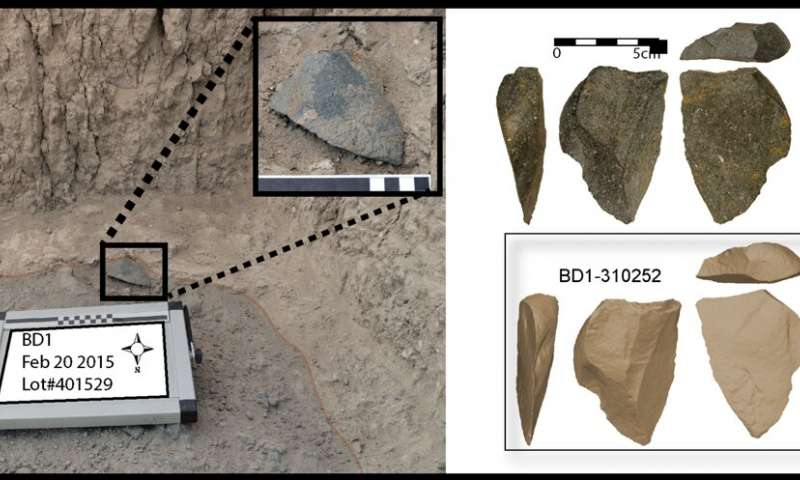A collection of stone tools carved more than 2.58 million years ago have been found in Ethiopia
A new archaeological site discovered by an international and local team of scientists working in Ethiopia shows that the origins of stone tool production are older than 2.58 million years ago. Previously, the oldest evidence for systematic stone tool production and use was 2.58 to 2.55 million years ago.
Analysis by the researchers of early stone age sites, published this week in the Proceedings of the National Academy of Sciences, suggests that stone tools may have been invented many times in many ways1 before becoming an essential part of the human lineage.
- 1.
It appears that this shift in tool making occurred around the same time that our ancestor's teeth began to change. This can be seen in the Homo jaw from Ledi-Geraru. As our ancestors began to process food prior to eating using using stone tools, we start to see a reduction in the size of their teeth. Our technology and biology were intimately intertwined even as early as 2.6 million years ago.
David R. Braun el al., "Earliest known Oldowan artifacts at >2.58 Ma from Ledi-Geraru, Ethiopia, highlight early technological diversity," PNAS (2019).
David R. Braun, Vera Aldeias, Will Archer, J Ramon Arrowsmith, Niguss Baraki, Christopher J. Campisano, Alan L. Deino, Erin N. DiMaggio, Guillaume Dupont-Nivet, Blade Engda, David A. Feary, Dominique I. Garello, Zenash Kerfelew, Shannon P. McPherron, David B. Patterson, Jonathan S. Reeves, Jessica C. Thompson, and Kaye E. Reed
PNAS first published June 3, 2019 https://doi.org/10.1073/pnas.1820177116
Significance: Humans are distinguished from all other primates by their reliance on tool use. When this uniquely human feature began is debated. Evidence of tool use in human ancestors now extends almost 3.3 Ma and becomes prevalent only after 2.6 Ma with the Oldowan. Here, we report a new Oldowan locality (BD 1) that dates prior to 2.6 Ma. These earliest Oldowan tools are distinctive from the 3.3 Ma assemblage and from materials that modern nonhuman primates produce. So, although tool production and use represent a generalized trait of many primates, including human ancestors, the production of Oldowan stone artifacts appears to mark a systematic shift in tool manufacture that occurs at a time of major environmental changes.
Abstract: The manufacture of flaked stone artifacts represents a major milestone in the technology of the human lineage. Although the earliest production of primitive stone tools, predating the genus Homo and emphasizing percussive activities, has been reported at 3.3 million years ago (Ma) from Lomekwi, Kenya, the systematic production of sharp-edged stone tools is unknown before the 2.58–2.55 Ma Oldowan assemblages from Gona, Ethiopia. The organized production of Oldowan stone artifacts is part of a suite of characteristics that is often associated with the adaptive grade shift linked to the genus Homo. Recent discoveries from Ledi-Geraru (LG), Ethiopia, place the first occurrence of Homo ∼250 thousand years earlier than the Oldowan at Gona. Here, we describe a substantial assemblage of systematically flaked stone tools excavated in situ from a stratigraphically constrained context [Bokol Dora 1, (BD 1) hereafter] at LG bracketed between 2.61 and 2.58 Ma. Although perhaps more primitive in some respects, quantitative analysis suggests the BD 1 assemblage fits more closely with the variability previously described for the Oldowan than with the earlier Lomekwian or with stone tools produced by modern nonhuman primates. These differences suggest that hominin technology is distinctly different from generalized tool use that may be a shared feature of much of the primate lineage. The BD 1 assemblage, near the origin of our genus, provides a link between behavioral adaptations—in the form of flaked stone artifacts—and the biological evolution of our ancestors.
Keywods: Oldowan, stone tools, Homo, cultural evolution, paleoanthropology
